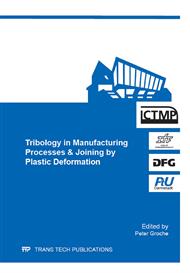[1]
Nalla, R. K., Altenberger, I., Noster, U., Liu, G. Y., Scholtes, B., and Ritchie, R. O., On the Influence of Mechanical Surface Treatments-Deep Rolling and Laser Shock peening-On the Fatigue Behavior of Ti–6Al–4V at Ambient and Elevated Temperatures, Materials Science and Engineering: A, 2003, 355(1–2), pp.216-230.
DOI: 10.1016/s0921-5093(03)00069-8
Google Scholar
[2]
Choi, K. S., Pan, J., and Ho, S., Fatigue Failures of Rollers in Crankshaft Fillet Rolling, SAE Technical Paper 2004-01-1498, (2004).
DOI: 10.4271/2004-01-1498
Google Scholar
[3]
Choi, K. S. and Pan, J., 2009, Simulations of Stress Distributions in Crankshaft Sections Under Fillet Rolling and Bending Fatigue Tests, International Journal of Fatigue, 2009, 31(3), pp.544-557.
DOI: 10.1016/j.ijfatigue.2008.03.035
Google Scholar
[4]
Kloos, K. H. and Adelmann, J., Schwingfestigkeitssteigerung durch Festwalzen, Materialwissenschaft und Werkstofftechnik, 1998, 19(1), pp.15-2.
DOI: 10.1002/mawe.19880190103
Google Scholar
[5]
Yen, Y. C., Sartkulvanich, P., and Altan, T., Finite Element Modeling of Roller Burnishing Process, CIRP Annals - Manufacturing Technology, 2005, 54(1), pp.237-240.
DOI: 10.1016/s0007-8506(07)60092-4
Google Scholar
[6]
Sartkulvanich, P., Altan, T., Jasso, F., and Rodriguez, C., Finite Element Modeling of Hard Roller Burnishing: An Analysis on the Effects of Process Parameters Upon Surface Finish and Residual Stresses, Journal of Manufacturing Science and Engineering, 2007, 129(4), pp.705-716.
DOI: 10.1115/1.2738121
Google Scholar
[7]
Ali, M. and Pan, J., Effect of a Deformable Roller on Residual Stress Distribution for Elastic-Plastic Flat Plate Rolling Under Plane Strain Conditions, SAE International Journal of Material and Manufacturing, 2012, 5(1), pp.129-142.
DOI: 10.4271/2012-01-0190
Google Scholar
[8]
Guagliano, M. and Vergani, L., Residual Stresses Induced by Deep Rolling in Notched Components, Metallurgical Science and Technology, 1996, 14(2), pp.61-68.
Google Scholar
[9]
Choi, K. S. and Pan, J., Effects of Pressure-Sensitive Yielding on Stress Distributions in Crankshaft Sections Under Fillet Rolling and Bending Fatigue Tests, International Journal of Fatigue, 2009, 31(10), pp.1588-1597.
DOI: 10.1016/j.ijfatigue.2009.04.007
Google Scholar
[10]
Majzoobi, G. H., Azadikhah, K., and Nemati, J., The Effects of Deep Rolling and Shot Peening on Fretting Fatigue Resistance of Aluminum-7075-T6, Materials Science and Engineering: A, 2009, 516(1-2), pp.235-247.
DOI: 10.1016/j.msea.2009.03.020
Google Scholar
[11]
Fu, C. H., Guo, Y. B., McKinney, J., and Wei, X. T., Process Mechanics of Low Plasticity Burnishing of Nitinol Alloy, Journal of Materials Engineering and Performance, 2012, 21(12), pp.2607-2617.
DOI: 10.1007/s11665-012-0313-1
Google Scholar
[12]
Sayahi, M., Sghaier, S., and Belhadjsalah, H., Finite Element Analysis of Ball Burnishing Process: Comparisons Between Numerical Results and Experiments, International Journal of Advanced Manufacturing Technology, 2013, 67(5-8), pp.1665-1673.
DOI: 10.1007/s00170-012-4599-9
Google Scholar
[13]
Klocke, F, Bäcker, V, Wegner, H, and Zimmermann, M, Finite Element Analysis of the Roller Burnishing Process for Fatigue Resistance Increase of Engine Components, Proceedings of the Institution of Mechanical Engineers, Part B: Journal of Engineering Manufacture, 2011, 225(1), pp.2-11.
DOI: 10.1243/09544054jem2044
Google Scholar
[14]
SIMULIA, 2012, ABAQUS User's Manual, Version 6. 12, Providence, RI, USA.
Google Scholar
[15]
Li, L. and He, N., A FEA Study on Mechanisms of Saw-Tooth Chip Deformation in High Speed Cutting of Ti-6-Al-4V Alloy, Proceedings of the Fifth International Conference on High Speed Machining, Metz, France, 2006, pp.759-767.
Google Scholar
[16]
Calamaz, M., Coupard, D., and Girot, F., A New Material Model for 2D Numerical Simulation of Serrated Chip Formation When Machining Titanium Alloy Ti–6Al–4V, International Journal of Machine Tools and Manufacture, 2008, 48(3–4), pp.275-288.
DOI: 10.1016/j.ijmachtools.2007.10.014
Google Scholar
[17]
Heathcote, H. L., The Ball Bearing: In the Making, Under Test and on Service, Proceedings of the Institute of Automobile Engineers, 1921, 15, p.569.
Google Scholar
[18]
Johnson, K. L., Contact Mechanics, Cambridge: Cambridge University Press, (1985).
Google Scholar


